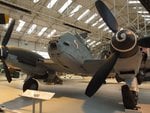YakFlyer
Airman 1st Class
One could best sum up the abilities in the Zestorer, in two allied aircraft, the P-51, and the Mosquito. The story of the Zestorer must be considered a failure, certainly in day-time ops. It is all very well saying that they were not designed to tangle with single engine fighters, but what if one appears in combat, you have no choice. They had no ability dogfighting. The Mosquito and the '51 did the two jobs so sucessfully, that the Zestorers failed with doing at once.


